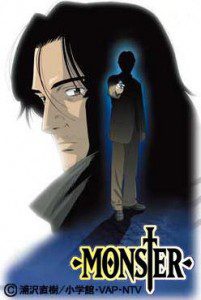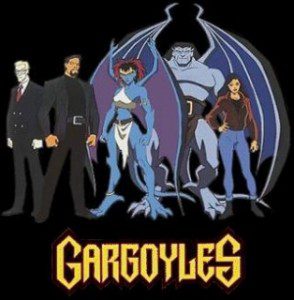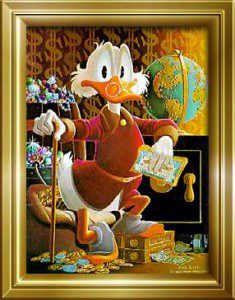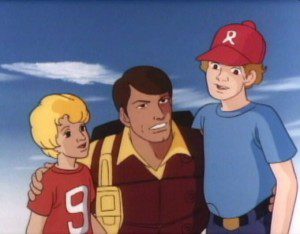How many times has this happened to you? You discover a truly amazing anime, one that completely changes your life. Compelling characters; intriguing, twisting and developed story; moody, completely appropriate art. It changes the way you view the medium so much, that you feel the need, no, the duty, to tell other people about it, especially those who are unfamiliar with the medium as a whole. And they listen to your passionate words with smiles, nod, and tell you “it sounds nice, but I prefer real television shows.”
Infuriating, isn’t it. For a long time, anime aficionados have found themselves having to justify their love for eastern animated fare, often when those shows are more satisfying, better written, acted and produced than anything on American television. In a market dominated by reality TV and formulaic dramas and sitcoms, some aged well past their prime, but holding on due to sheer stubbornness of their viewer base, anime can provide a refuge with fresh series, geared towards any number of interests and tastes, that are satisfying and worthy of the time and energy investment.
 For example, take a look at the series “Monster.” For those who are not familiar with this series, it is a crime drama set in Germany shortly after the reunification of the east and west. It revolves around a young, hotshot prodigy brain surgeon Kenzo Tenma, who defies the orders of his supervisor and saves the life of a young boy who had been shot in the head over the life of the mayor of Munich, because it is the “right thing to do” in following protocol. Because of this “insubordination,” he finds himself stripped of everything he once enjoyed in life, right down to his fiancee, the daughter of the hospital director. At the end of his rope and embroiled in a full on crisis of faith, knowing full well that every ambition he once had will never come to pass, and contemplating resigning from the medical profession, he discovers the director and his rival doctors dead, and the boy he saved gone. What follows is a breakneck series full of mystery, suspense, philosophy and human nature.
For example, take a look at the series “Monster.” For those who are not familiar with this series, it is a crime drama set in Germany shortly after the reunification of the east and west. It revolves around a young, hotshot prodigy brain surgeon Kenzo Tenma, who defies the orders of his supervisor and saves the life of a young boy who had been shot in the head over the life of the mayor of Munich, because it is the “right thing to do” in following protocol. Because of this “insubordination,” he finds himself stripped of everything he once enjoyed in life, right down to his fiancee, the daughter of the hospital director. At the end of his rope and embroiled in a full on crisis of faith, knowing full well that every ambition he once had will never come to pass, and contemplating resigning from the medical profession, he discovers the director and his rival doctors dead, and the boy he saved gone. What follows is a breakneck series full of mystery, suspense, philosophy and human nature.
And above all, a series that would make a marvelous addition to any television network. Not since early Law and Order or CSI has a crime drama been so riveting and fully realized, mixing high emotion with deep storytelling and fitting, edgy art. The manga version of the story (which is nearly identical to the anime version, and possibly the most faithful adaptation of a book series I’ve ever seen) was nominated for several awards, the show has been translated into numerous languages and has received international acclaim for its pacing, developed story and suspense.
And this is what I tried to convey to a friend in order to get her to watch the show. Since she loves crime dramas, and has been a devoted watcher of CSI, L&O, NCIS and Bones, I thought it was right up her alley, with enough twists and turns to completely throw her off course. Her response?
“I only watch shows with real people who have real personalities, not cartoons.”

Needless to say, I was rather dejected after that.
Since I began watching anime, and indeed moved beyond looking at anime as merely cartoons with crazy art and fantastic settings, I began to notice how much of it is truly exemplary. A lot of the shows I have enjoyed over the years have left me just as satisfied as some of the best scripted, live dramas and comedies on American TV. Even with giant robots (and sometimes because of them), many of the shows I have grown to love exhibit all the characteristics of the best television I have ever seen anywhere. And yet, because it does not use “real people,” it gets ignored.

Part of me wants to blame the stereotypes and connotations found within western animation. Growing up, one of the most compelling western shows I watched was “Gargoyles,” one of Disney’s misunderstood and under appreciated heroes of weekday afternoon television. Take away the “stone by day” nature of the animated warriors and what was left was a lovely jaunt into the world of speculative science, philosophy and William Shakespeare, upon whose plays “Macbeth” and “A Midsummer Night’s Dream” the series paid heavy homage to. And unlike many other mainstays of children’s TV, Gargoyles still manages to be compelling and edgy by modern standards, testing the limits of both intellectual/philosophical storytelling and its balance alongside mindless violence and the supernatural. But alas, in many cases Gargoyles was the exception, not the rule, and I was still judged for being that strange fourteen year old kid who raced home to watch cartoons after school.
We can tote how much anime has invaded our pop culture, as Roland Kelts did in his amazing book “Japanamerica.” We can see how much of the influence is found in western created shows like Avatar, Teen Titans, Batman Beyond and X-Men Evolution. We can read into the depth of Evangelion and Cowboy Bebop, and then we must ask, will it ever be enough? Or is the deck stacked too much against the animation medium for it to ever be taken seriously? I laughed harder at Ouran High School Host Club than I ever have at a western show, and the romantic comedies of anime easily surpass the often lowball humor of top-rated American sitcoms. And given the ability for animation to often accomplish with a small budget what live-acted shows can take millions of dollars to achieve, it even makes sense fiscally for struggling networks and viewers to find something to love in the eastern animation sphere. But why, then, is it still finding space only in the deeper recesses of cable television, hidden behind the general public image of “Cartoon Network” or “SyFy?”

One of the reasons Kelts says anime became such a juggernaut in the western world is because of the fact that it does NOT follow the rules found in American animation. The good guys do not always win. The good guys are not always that “good.” In a society where good and evil are often equated with black and white, morally upright versus morally devoid, the gray area of anime and its ambiguity found a strong foothold among youth discovering that the world is indeed not all black and white. Shinji Ikari needs to save the world, he is the only one who can fight against the angels. But Shinji is horribly naive, lacks self esteem, desires a lot of things he cannot have, confronts lust, confronts sloth, needs confidence, needs his father’s love (or at least his acceptance)- the list goes on forever. He is so much like us that he relates to viewers on a level rarely found in western animation. And he fails. He runs away. Could you imagine Superman running away? Or Goliath? Or Popeye, for that matter?

Robert V Aldrich makes mention of this fact when he describes how the everyman is such a prominent force in anime. Unlike western shows, where often the protagonist has special powers or is himself a respected (or feared) force of the world (Superman, Batman, Bob from the groundbreaking series Reboot, Scrooge McDuck and pretty much anyone from G.I. Joe or Transformers come to mind), many of the anime protagonists lack this. In fact, in most circumstances, the protagonist finds himself thrust into the action without training, on a lick-and-a-promise moment that will shape the rest of his or her life. With the possible exception of Spider-man and Lion-O from Thundercats, you would be hard pressed to find similar examples within western culture. And even with the two aforementioned, it must be duly noted that the very appeal found within those two series stems from the fact that, at least initially, they were intended to be flawed, characters. Through the awkwardness of Peter Parker, it was thought that “normal” kids everywhere would be able to relate to his adventures, sympathize with his difficulties and cheer for his exploits. And despite being the leader of the Thundercats, Lion-O was still a teenager at heart, forced to be a warrior when his stasis tube malfunctioned, and he had to confront the perils of responsibility while still tackling his raging emotions.
But unfortunately, this is more an exception than the rule. And cartoons move on, saddled with a stereotype that they are just for children, that they hold no deeper meanings and should be discarded upon reaching adulthood. They are often remembered more for slapstick humor or questionable actions than any of the deeper social commentary they carried with them. They, along with the comic books of the early 20th Century, were even looked at as a form of deviant behavior and maligned by some. Looking back at Looney Tunes from the 1940s, or at Popeye from the 1920s and 1930s, just underneath the surface of the often hilarious actions the characters made were social criticisms of war, poverty, public health and, yes, also deviancy. The early Warner Brothers cartoon series were even utilized by the government as a mode of propaganda during World War Two because they reached such a wide audience back in their day, an audience that went beyond just children and often had followers well into adulthood. And while these trends and themes started to slow as animation entered the 1980s (GI Joe was educational because it promoted patriotism? Seriously?), the introduction of anime gave it new life and a shot in the arm from which it has yet to come down.

I suppose the point I am making (and yes, I am trying to make a point here), is that anime is more than just a cartoon, and needs to be recognized as such. Just because a show is hand drawn does not mean it lacks what makes “live” shows worth watching. And just because someone chooses to watch said shows does not make them childish or immature. Rather, it shows that the viewer is more interested in experiencing television and television culture to their fullest, and will not allow labels to color their perception. If a show, or a movie, or a manga, is internationally acclaimed and has won accolades for its groundbreaking character depictions or devotion to history or gut-wrenching storytelling style, why should it not receive just as much attention as a book or show from an “established” author, producer or director? Does the inclusion of animation mean that everyone else is wrong? Does it make the media substandard to “traditional” fare? We live in a nation where “Watchmen” is considered one of the finest novels ever written. Not graphic novels, novels in general, and has been praised for its own take on social critique. Who knows, maybe the next show you watch might be the one that changes your life?
And if all else fails, you could always try to point out that Japanese adults consume just as much anime and manga as children and teens do, AND they are some of the most effective human beings on the planet. Just saying…


Agree with the above.
I step in and out of anime, but on the whole, I enjoy anime more than most of the live-action TV these days. I also like the anime art style as it relates to TV shows and video games.
Anime is not all “moe”, contrary to what detractors think. Miyazaki still produces very thoughtful movies. Games like Final Fantasy and Resident Evil do a good job at blending anime with realism, and that is the look I prefer for “realistic” games.
I think I started seeing the distinction when I watched Gundam SEED Destiny back in 05. I would watch each episode the day it came out, and remarked on how much more depth was put into the story and how much more human the characters were.
And yet, it still has this huge “stigma” attached to it.
I really enjoyed this. Funny I got a chance to catch up today as I told one of my customers to watch Paprika … then Inception … then Paprika again. They touch & agree, but the anime is so much more in depth.
I really believe that since it IS animation you have a larger pallet in terms of being able to create and not just effectively, but FULLY, communicate ideas, theories, thoughts, etc. In real life its too limiting.
[…] Monster- Whenever I get the chance, I tell people about this series. In an age when half the scripted shows on television are crime procedurals, Monster stands both […]
What I find MORE interesting is the way in which anime’s comedic pacing and sensibilities have bled into mainstream, live action TV. Anyone who tells you that How I Met Your Mother or Community doesn’t seem like it could be an anime is lying.